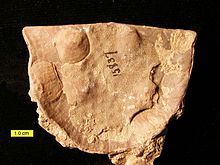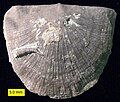
Craniata is a class of brachiopods originating in the Cambrian period and still extant today. It is the only class within the subphylum Craniiformea, one of three major subphyla of brachiopods alongside linguliforms and rhynchonelliforms. Craniata is divided into three orders: the extinct Craniopsida and Trimerellida, and the living Craniida, which provides most information on their biology. Living members of the class have shells which are composed of calcite, though some extinct forms my have aragonite shells. The shells are inarticulate and are usually rounded in outline. There is no pedicle; the rear edge of the body cavity is a smooth and flat wall perforated by the anus. This class of brachiopods has an unsupported lophophore with only a single row of tentacles. In the absence of a pedicle, the shell is usually attached directly to a hard substrate. Many craniiforms are encrusting animals which attach directly to the shell of another animal, usually another brachiopod. The plicae from the host brachiopod will then appear within the shell of the craniiform.

The taxonomic order Rhynchonellida is one of the two main groups of living articulate brachiopods, the other being the order Terebratulida. They are recognized by their strongly ribbed wedge-shaped or nut-like shells, and the very short hinge line.

Orthida is an extinct order of brachiopods which appeared during the Early Cambrian period and became very diverse by the Ordovician, living in shallow-shelf seas. Orthids are the oldest member of the subphylum Rhynchonelliformea, and is the order from which all other brachiopods of this group stem. Physically they are usually strophic, with well-developed interareas. They also commonly have radiating ribs, sulcus, and fold structures. Typically one valve, often the brachial valve, is flatter than the other. The interior structure of the brachial valves are usually simple. In shape they are sub-circular to elliptical, with typically biconvex valves.
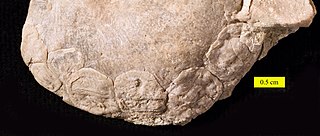
The Craniidae are a family of brachiopods, the only surviving members of the subphylum Craniiformea. They are the only members of the order Craniida, the monotypic suborder Craniidina, and the superfamily Cranioidea; consequently, the latter two taxa are at present redundant and rarely used.There are three living genera within Craniidae: Neoancistrocrania, Novocrania, and Valdiviathyris. As adults, craniids either live freely on the ocean floor or, more commonly, cement themselves onto a hard object with all or part of the ventral valve.

Atrypa is a genus of brachiopod with round to short egg-shaped shells covered with many fine radial ridges. Growth lines form perpendicular to the costae and are spaced approximately 2 to 3 times further apart than the costae.. The pedunculate valve is slightly convex, but oftentimes levels out or becomes slightly concave toward the anterior margin. The brachial valve is highly convex. Neither valve contains an interarea. Atrypa had a large geographic range and occurred from the late Lower Silurian (Telychian) to the early Upper Devonian (Frasnian). Other sources expand the range from the Late Ordovician to Carboniferous, approximately from 449 to 336 Ma. A proposed new species, A. harrisi, was found in the trilobite-rich Floresta Formation in Boyacá, Colombia.
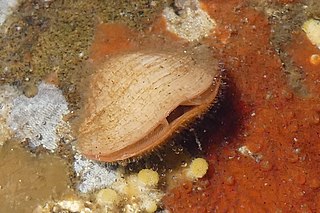
Brachiopods, phylum Brachiopoda, are a phylum of trochozoan animals that have hard "valves" (shells) on the upper and lower surfaces, unlike the left and right arrangement in bivalve molluscs. Brachiopod valves are hinged at the rear end, while the front can be opened for feeding or closed for protection. Two major categories are traditionally recognized, articulate and inarticulate brachiopods. The word "articulate" is used to describe the tooth-and-groove structures of the valve-hinge which is present in the articulate group, and absent from the inarticulate group. This is the leading diagnostic skeletal feature, by which the two main groups can be readily distinguished as fossils. Articulate brachiopods have toothed hinges and simple, vertically oriented opening and closing muscles. Conversely, inarticulate brachiopods have weak, untoothed hinges and a more complex system of vertical and oblique (diagonal) muscles used to keep the two valves aligned. In many brachiopods, a stalk-like pedicle projects from an opening near the hinge of one of the valves, known as the pedicle or ventral valve. The pedicle, when present, keeps the animal anchored to the seabed but clear of sediment which would obstruct the opening.

The origin of the brachiopods is uncertain; they either arose from reduction of a multi-plated tubular organism, or from the folding of a slug-like organism with a protective shell on either end. Since their Cambrian origin, the phylum rose to a Palaeozoic dominance, but dwindled during the Mesozoic.
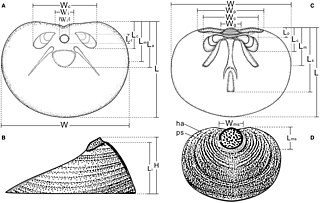
Acrotretides (Acrotretida) are an extinct order of linguliform brachiopods in the class Lingulata. Acrotretida contains 8 families within the sole superfamily Acrotretoidea. They lived from the Lower Cambrian to the Middle Devonian, rapidly diversifying during the middle Cambrian. In the upper Cambrian, linguliforms reached the apex of their diversity: acrotretides and their relatives the lingulides together comprised nearly 70% of brachiopod genera at this time. Though acrotretides continued to diversify during the Ordovician, their proportional dominance declined, as rhynchonelliforms took on a larger role in brachiopod faunas.

Rhynchonelliformea is a major subphylum and clade of brachiopods. It is roughly equivalent to the former class Articulata, which was used previously in brachiopod taxonomy up until the 1990s. These so-called articulated brachiopods have many anatomical differences relative to "inarticulate" brachiopods of the subphyla Linguliformea and Craniformea. Articulates have hard calcium carbonate shells with tongue-and-groove hinge articulations and separate sets of simple opening and closing muscles.

The Rhynchonellata is a class of Lower Cambrian to Recent articulate brachiopods that combines orders from within the Rhynchonelliformea with well developed pedicle attachment. Shell forms vary from those with wide hinge lines to beaked forms with virtually no hinge line and from generally smooth to strongly plicate. Most all are biconvex. Lophophores vary and include both looped and spiraled forms. Although morphologically distinct, included orders follow a consistent phylogenetic sequence.

Gigantoproductus giganteus is an extinct species of brachiopods in the family Monticuliferidae, known only from its fossil remains. It was a marine invertebrate found on the seabed in shallow seas. It evolved during the Carboniferous period and it is believed to be the largest brachiopod that has ever existed.

Paterinata is an extinct class of linguliform brachiopods which lived from the lower Cambrian ("Tommotian") to the Upper Ordovician (Hirnantian). It contains the single order Paterinida and the subfamily Paterinoidea. Despite being some of the earliest brachiopods to appear in the fossil record, paterinides stayed as a relatively subdued and low-diversity group even as other brachiopods diversified later in the Cambrian and Ordovician. Paterinides are notable for their high degree of convergent evolution with rhynchonelliform (articulate) brachiopods, which have a similar set of muscles and hinge-adjacent structures.
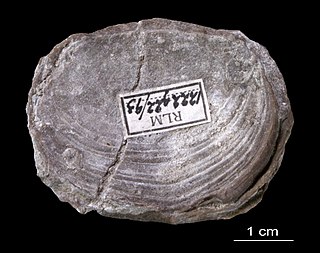
Trimerellida is an extinct order of craniate brachiopods, containing the sole superfamily Trimerelloidea and the families Adensuidae, Trimerellidae, and Ussuniidae. Trimerellidae was a widespread family of warm-water brachiopods ranging from the Middle Ordovician to the late Silurian (Ludlow). Adensuidae and Ussuniidae are monogeneric families restricted to the Ordovician of Kazakhstan. Most individuals were free-living, though some clustered into large congregations similar to modern oyster reefs.

Argyrotheca is a genus of very small to minute lampshells. All species share a large pedicel opening, one ridge on the inside of the pedunculate valve, pits in a diamond pattern on the inside of both valves, and without radial ridges that end in tubercles. It occurs in depths between 6 and 1300 m. It is known since the latest Cretaceous.

Strophomenata is an extinct class of brachiopods in the subphylum Rhynchonelliformea.

Siphonotretida is an extinct order of linguliform brachiopods in the class Lingulata. The order is equivalent to the sole superfamily Siphonotretoidea, itself containing the sole family Siphonotretidae. Siphonotretoids were originally named as a superfamily of Acrotretida, before being raised to their own order.

Kutorginates (Kutorginata) are an extinct class of early rhynchonelliform ("articulate") brachiopods. The class contains only a single order, Kutorginida (kutorginides). Kutorginides were among the earliest rhynchonelliforms, restricted to the lower-middle part of the Cambrian Period.
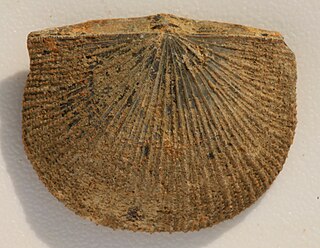
The orthotetides (Orthotetida) are an extinct order of brachiopods in the class Strophomenata. Though not particularly diverse or abundant relative to strophomenides (Strophomenida) or productides (Productida), orthotetides were nevertheless the longest-lasting order of strophomenates, surviving from the Middle Ordovician (“Llanvirn”) up until the Late Permian. Externally, many orthotetides are difficult to distinguish from strophomenides. Most fundamental differences between the two orders are internal: orthotetides have more elaborate cardinal processes and a greater diversity of shell microstructure.
Paleontology or palaeontology is the study of prehistoric life forms on Earth through the examination of plant and animal fossils. This includes the study of body fossils, tracks (ichnites), burrows, cast-off parts, fossilised feces (coprolites), palynomorphs and chemical residues. Because humans have encountered fossils for millennia, paleontology has a long history both before and after becoming formalized as a science. This article records significant discoveries and events related to paleontology that occurred or were published in the year 2019.
Pugnoides is an extinct genus of brachiopod belonging to the order Rhynchonellida and family Petasmariidae. Specimens have been found in Devonian to Permian beds in North America, Asia, Europe, western Australia, New Zealand,and New Zealand. The genus was particularly widespread in the Visean.
